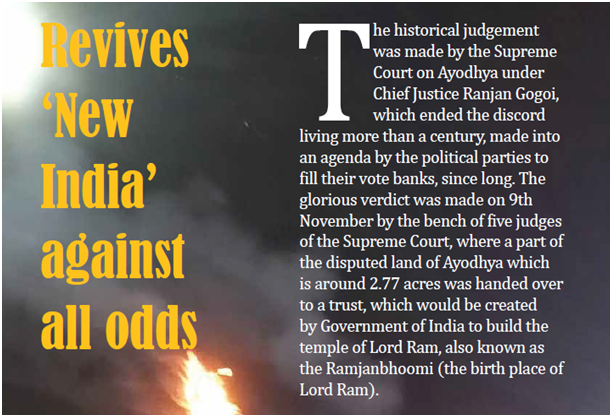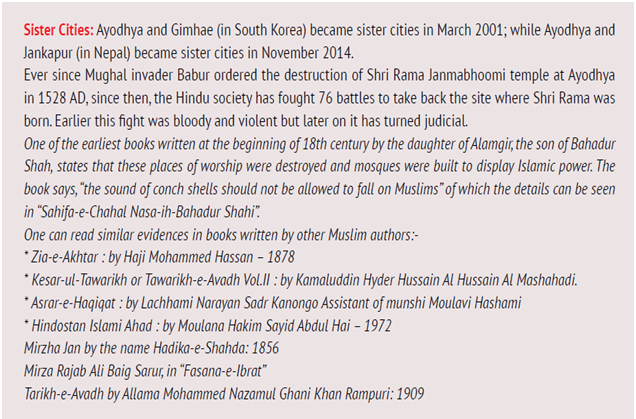
Not making it biased, keeping in mind the equality and respect of both the religion, the Supreme Court gave an alternate land of 5 acres to the Sunni Waqf Board for the purpose of building the mosque. It was also cleared by the court that 5 acres is restitution for the unlawful destruction of mosque held way back in 1992 over the disputed area in violation of the status quo orders of the court.
What is more appealing is that the Sunni Waqf Board accepted the Supreme Court decision and decided not to file the review petition against the decision of the Court. This shows that the decision had cemented the clash between the Hindus & Muslims agenda peacefully. The National Commission for Minorities Chairperson Ghayorul Hasan Rizvi had also openly accepted the verdict and has extended their helping hands, where Muslims would help in building the temple in Ayodhya while Hindus should help in the construction of the mosque. He said, it would prove to be a milestone in strengthening the social harmony between the two communities. We are simply against those leaders who use religion for politics, now and again to gain vote.
and decided not to file the review petition against the decision of the Court. This shows that the decision had cemented the clash between the Hindus & Muslims agenda peacefully. The National Commission for Minorities Chairperson Ghayorul Hasan Rizvi had also openly accepted the verdict and has extended their helping hands, where Muslims would help in building the temple in Ayodhya while Hindus should help in the construction of the mosque. He said, it would prove to be a milestone in strengthening the social harmony between the two communities. We are simply against those leaders who use religion for politics, now and again to gain vote.
Prime Minister Narendra Modi also hailed the decision, and mentioned that it had settled a long standing matter which in other way is also said to be a political boost to his regime. The main opposition Congress party also welcomed the court’s verdict and appealed all parties to maintain peace and harmony in the country. The five judges started daily proceedings in August this year after mediation failed to find a compromise.
On the other hand, Senior Supreme Court judges praised Chief Justice Ranjan Gogoi for the landmark unanimous verdict on the Ayodhya case. At a book launch in Guwahati, Chief Justice-Designate SA Bobde said Chief Justice Gogoi's "grit, mettle and character" are so strong that it is difficult to get anything wrong passed.
He added. "Democracy is designed for welfare of all citizens and an independent judiciary is one of the instruments to be used for that purpose."
Another Senior Judge, Justice Arun Mishra, said Chief Justice Gogoi decided the "most important indecision" that the country was facing. He has achieved impossible with the 1,000-page judgement within two-three weeks. This is rather the most impossible task achieved by his regime. He shows not determination to decide that case, but what the Supreme Court has capability of doing and what it can achieve making a name in the history".
Justice Mishra said, the judiciary is going through a critical phase, where people want to control everything but Chief Justice Gogoi has provided insulation, courage and quality through his decisions. He has made this country indebted with his decisions and will be remembered for his courage and determination in delivering the verdicts.
Justice Shripathi Ravindra Bhat said, “We saw one history, which I am sure when all the dust has settled, will remain indelible in Indian judicial history that the courts spoke in one word. It was a turning point in the history that the court stood because when the court speaks, it speaks for the Constitution, he said.
History
Ayodhya is also called Oudh or Awadh, town situated in south-central Uttar Pradesh state, northern India. It lies on the Ghaghara River just east of Faizabad. An ancient town, Ayodhya is regarded as one of the seven sacred cities of the Hindus, revered because of its association in the great Indian epic poem Ramayana with the birth of Rama and with the rule of his father, Dasharatha. According to this source, the town was prosperous and well fortified and had a large population.
History of Ayodhya, Uttar Pradesh, India is a fascinating one. According to the ancient history, Ayodhya was one of the holiest cities where the religious faiths of Hinduism, Buddhism, Islam and Jainism united together to build a place of enormous sacred importance.
Ayodhya history is a chequered one. In the Atharvaveda, this place was described as a city that was made by gods and was as prosperous as heaven itself. The powerful kingdom of ancient Kosala had Ayodhya as its capital. This city was also a significant trade centre in 600 BC. Historians have identified this place to be Saketa, a key Buddhist centre during the 5th century BC which it remained till the 5th century AD. In fact, Fa-hien, the Chinese monk, kept record of several Buddhist monasteries that he saw here.
Ayodhya has a historical significance for the Jain community too. This is the birth place of two important Jain tirthankaras who were born in the early centuries AD. Jain texts also stand testimony to the visit of Mahavira, Jainism's founder to this city.
The Kanauj kingdom arose in Ayodhya, then called Oudh, during the 11th and 12th centuries CE. The region was later included in the Delhi sultanate, the Jaunpur kingdom, and, in the 16th century, the Mughal Empire. Oudh gained a measure of independence early in the 18th century but became subordinate to the British East India Company in 1764. In 1856, it was annexed by the British; the annexation and subsequent loss of rights by the hereditary land revenue receivers provided one of the causes of the Indian Mutiny in 1857. Oudh was joined with the Agra Presidency in 1877 to form the North-Western Provinces and later the United Provinces of Agra and Oudh, now Uttar Pradesh state.
Despite the town’s great age, there are few surviving monuments of any antiquity. The Babri Masjid was built in the early 16th century by the Mughal emperor Bābur on a site traditionally identified as Rama’s birthplace and as the location of an ancient Hindu temple, the Ram Janmabhoomi. Because of its significance to both Hindus and Muslims, the site was often a matter of contention. In 1990, riots in northern India followed the storming of the mosque by Hindu nationalists’ intent on erecting a temple on the site; the ensuing crisis brought down the Indian government. Two years later, on December 6, 1992, the three-story mosque was demolished within few hours by a crowd of Hindu nationalists. It was estimated that more than 2,000 people died in the rioting that swept through India following the mosque’s destruction.
An investigative commission led by Manmohan Singh Liberhan, a retired judge, was formed in 1992 but did not issue a report until 2009. The report, when it finally appeared, caused uproar because it blamed several leading figures from the pro-Hindu Bharatiya Janata Party for the mosque’s destruction. A court ruling in 2010 divided the land between Hindus and Muslims, but that decision was overturned in 2019 by the Supreme Court.
Reviews:
Prime Minister Narendra Modi: "After the verdict, the way every section of society of every religion, has welcomed it is a proof of India's ancient culture and tradition of social harmony. There is no place for fear, bitterness and negativity in 'New India'. Whether it's Ramashakti or Rahimshakti, this is the time to strengthen the spirit of Bharatbhakti".
To read the further articles please get your copy of Eastern Panorama December issue @http://www.magzter.com/IN/Hill-Publications/Eastern-Panorama/News/ or mail to contact @easternpanorama.in


